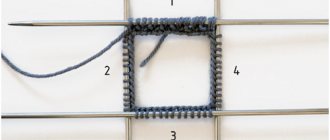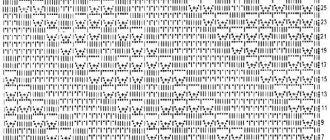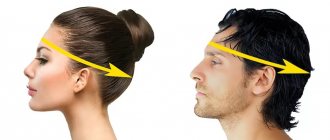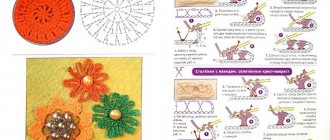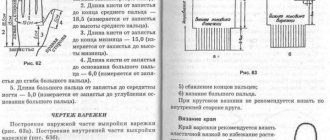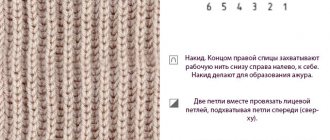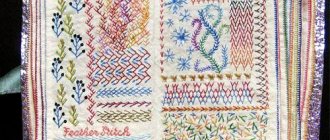A half crochet crochet without a crochet is considered an auxiliary element; it even has a second name - a connecting loop. This method is most often used to connect a chain of air loops into a ring, tie an element (for example, an arch) to the main fabric, or stitch two parts.
However, the half-column also has independent potential, since when done correctly it gives an effective pattern in the form of braids, reminiscent of a “chain stitch” in embroidery.
Tools and materials
Half crochet single crochet is a knitting technique that fully confirms the popular wisdom: “What looks simple is the most difficult.”
A half crochet single crochet seems simple only at first glance.
The point is that such a column can be easily done once, as a connecting loop, or several times for practical purposes to assemble a product, but if you need to make a beautiful row with a half crochet braid or knit the entire product With this technique, you will have to make an effort.
The column has a very small height, the work moves slowly, so special attention must be paid to the selection of hook and yarn so that materials and tools do not slow down the process even more. The hook should move very easily. To do this, it is better to choose threads of medium thickness or thick, but with a smooth surface.
The following types of yarn are suitable for half-stitch:
- acrylic with added wool;
- not very thin cotton threads, you can knit with yarn such as “Iris” or “Narcissus”, but the work will be very long and painstaking.
The selection of hook is also important. A hook that is too thin will catch and fray the thread, and the pattern chain will be so small that it will be difficult to work with. At the same time, it will be impossible to place a very thick hook under one of the loop threads.
You can choose the right tool by placing the thread in the barb of the hook and pulling it slightly. If the thread completely occupies the notch, without going beyond the edges, but without dangling, then the hook is suitable. It is easiest to work with a half-stitch using metal hooks in the range No. 2 - 3.5, and yarn of the appropriate thickness.
The half-stitch is the easiest basic knitting method to master. However, in order to beautifully and accurately complete several rows of this single crochet stitch, you need to practice many times, analyze which crochet hook and which wool is more convenient for a particular craftswoman to knit, and practice hand movements.
How to knit
To learn how to knit a regular half-stitch, you need to cast on a few chain stitches, and then follow the simple instructions:
- First, you need to pass the hook into the second loop from the hook, skipping the lifting loop.
For a half-column, 1 loop is also left for lifting, as for a regular column.
- Then you should pick up the thread with your hook and pull it in one movement through the loop of the chain and the loop on the hook.
It is this 1st movement that needs to be automated in order to knit with a half-stitch quickly. The classic single crochet differs from the half double crochet in that it is performed in 2 movements.
- You need to continue this way until the end of the row, knitting each loop. Then you should make a lifting loop, turn the product over and continue the pattern.
It is important to immediately decide how the hook will fit to grab the thread.
You can pick up the entire braid of the previous row (that is, 2 threads), but it is difficult to knit this way, since the knitting turns out to be very tight. The second way is to pick up only the front wall of the braid (1 thread), this makes it easier to knit.
A half crochet single crochet with this method of knitting and changing colors gives a completely different pattern on the front and back sides. On the face it will be braids, and on the back it will be braids and stitching on the sides of the row.
In the diagram, a half-column is designated differently - if it is a connecting loop, then with a black triangle or circle, if it is just a single crochet, then with a vertical stick.
However, there is no clear division of functionality, and all three symbols are in use. In addition to symbols, knitters need to master basic abbreviations for basic techniques so they can quickly parse knitting instructions and create their own pattern.
Conventional abbreviations to remember:
| Knitting technique | Abbreviation |
| Air loop | VP |
| Single crochet | RLS |
| Half double crochet | Mon |
| Half double crochet (connecting loop) | PP |
| Double crochet | CH |
Half double crochets
Half-columns are also sometimes called one-and-a-half columns (PSSN). And now you will understand why. We start with a chain of VP. We make two lifting loops, since it is higher than a column without a bar. (1 lifting loop) and lower than the column with nak. (3 lifting loops). You need to make a yarn over, and then insert the hook into the third loop and pull the working thread towards you. Now we have 3 loops on the hook. The beginning is similar to knitting dc. Now we will grab the working thread and knit 3 loops at once. Half double crochet knitted!
Decoration "Snowflake"
Even a novice needlewoman can knit this patterned decoration in half an hour. To make this craft you only need to master chain stitches, double crochet and half single crochet.
An openwork snowflake can be attached to any woolen clothing or household item (pot holder, heating pad), and a standard item will become original and acquire a winter flavor. You can also attach a string to the snowflake and hang it on the Christmas tree. Also, children really like to play with knitted snowflakes, throwing them down.
Materials and tools:
- White yarn or any pastel color (medium thickness), such as baby yarn (acrylic with wool added).
- Hook No. 2.
Manufacturing process
The half crochet single crochet is the main technique in this project, as it gives a beautiful smooth braid, emphasizing the structure of the snowflake. It is better to knit the first snowflake clearly according to the pattern; then you can change the elements, for example, add partitions and rays.
How to knit:
- First, 11 air loops are knitted and connected into a ring with a connecting loop (half-column). Tie the ring with single crochets.
- From the last half-column you need to make 1 double crochet. We make 4 air loops, and through one loop we knit a double crochet, we get the first arch.
- Next, you should repeat this algorithm 5 times, if all the loops are counted correctly, then all the arches will be the same, the last 4 chain loops are attached to the first double crochet with a connecting loop.
At the next stage, rays are created, each ray is knitted in 3 stages:
- Knit 9 chain stitches, in the second row make 3 half double crochets, starting from the second loop from the hook.
This is the first of 3 branches of the ray.
- Then knit 5 air loops, perform 4 half-columns without knitting a lifting loop. The second branch is ready.
- Make 4 more air loops, from the second loop from the hook, knit half double crochets to the ring, continue to perform half double crochets along the ring until the next partition (double crochet). Next, knit the next ray according to the same algorithm.
When all six rays are ready, you need to hide the thread on the wrong side of the product or make a loop out of it.
A snowflake can be sewn on as decoration or hung on a Christmas tree. A small snowflake may even have plastic eyes.
Double crochets
Having understood how to knit stitches without stitches, it’s time to move on to stitches with stitches. (SSN). We tie the flail. from air loops (VP). Now we need to knit 3 loops for lifting, since Art. with nak. significantly higher than a simple sc. We make a yarn over, that is, we wrap a working thread around the hook, and insert it into the fourth loop from the hook. Grab the working thread and pull it towards you. Now we have 3 loops on the hook. We grab the working thread and knit a loop and yarn over. 2 loops left. Again we pick up the working thread and knit the remaining loops. That's all!
"Spider on the Web"
The Spider bookmark is a wonderful little souvenir for a friend, a colleague's child, or for yourself. This will make learning more fun. In addition, by increasing the size of the product, you can prepare original decorations for a theme party.
A novice craftswoman will spend about 40 minutes on the product. To knit a bookmark, you need to master only a few techniques - a chain loop, a half double crochet, a classic single crochet, a double crochet and a connecting loop. The main element is the half single crochet, as this technique clearly shows the interweaving of the web and the insect’s legs.
Materials and tools:
- Yarn of any color in one thread (can be cotton or acrylic with the addition of wool), medium thickness.
- Hook No. 2, hook No. 1.
- White cotton yarn or a piece of felt for the eyes.
- Needle with a large eye.
- The book is a model.
Manufacturing process
Making webs
The web is knitted according to the following algorithm:
- First, make 6 VPs and connect them using a PP into a ring. Tie the ring with single crochets.
- In the third row, make 1 dc, 4 ch from it, make another 1 dc through 1 loop, attach it to the ring through the loop, get the first arch, repeat the algorithm 5 times.
- In the fourth row, 6 more rays and 5 arches are made, respectively. Next, knit 1 dc, 6 chain stitches from it, then 1 dc, attach it to the web in the place where the dc was in the previous row. This is repeated 5 times. This is the optimal size of web for bookmarking.
- Next, the rays of the web are made along the edges, creating the illusion of attachment. In those places where there were double crochets in the previous row, make 4 VPs, tying them with half single crochets, continuing the tying in a circle until the next ray.
- At the final stage, a thread is made from the web to the spider from about 55 VP; the lace can be longer or shorter depending on the size of the book.
Making a spider
The spider can be knitted using this model, the number of loops can be changed along the way, focusing on your preferences - for example, the legs can be longer and the body larger:
- 6 PS, starting from the second loop from the hook (knit on air loops of the cord), this is a part of the body.
- For the 1st leg, 8 VP are knitted, 4 PP are made from the second loop from the hook, 2 VP are knitted, they are attached to the same loop with a connecting post, this is the joint of the insect’s leg (fold), then 3 PP are knitted. The last stitch is attached to the body, it turns out that the next leg is made through one loop.
- According to the pattern of the first paw, the remaining three paws on this side are knitted.
- Next, make the spider's head. Knit 3 sc in half double crochets from the previous row. After this, we make chelicerae for the spider (2 protrusions in the front of the head). Knit 1 sc in 1 loop, then 3 ch, then 1 sc in the same loop. It turns out to be a protrusion, the second protrusion is knitted according to the same pattern into the next loop. Then perform 6 PS, as on the other side at the very beginning.
- The spider's legs on this side are knitted in exactly the same way as the first four.
- Knit 3 sc on the head.
- At the end, the thread is secured, but not cut.
- You can attach eyes to the body of the spider using white felt or knitting them from cotton threads. The eyes are sewn on using a needle with a large eye and leaving a thread of the main color, while marking the pupils.
The bookmark is ready. At the end of the work, it is better to put it under something heavy for a while so that the lines straighten out. Using the same principle, you can make bookmarks in the shape of other animals - for example, fasten an octopus and a shell, then the octopus will have tentacles with suction cups, and the shell will be in the form of a spiral, which is convenient to knit with a half double crochet.
Let's analyze a simple and accessible pattern using half-columns
Try a very simple and quick pattern using half double crochets. To do this you need to knit a chain of air loops. Then you need to perform the following manipulations:
- Cast on three loops and make a single crochet.
- Cast on four loops and form a half double crochet.
- Form five loops and then a double crochet.
- Cast on six stitches and then make a double crochet stitch.
After this, knit everything in reverse order until a clove is formed. Use half-columns to connect two knitted elements, and also try crocheting the edges of the sleeves, collar or scarf. This way you will better master the various uses of such a crochet element as a half-stitch.
Bracelet "Celtic Knot of Passion"
Knowledge of basic knitting techniques allows you to create an original accessory in an ethnic style in a couple of hours. The color of the bracelet can be matched to any outfit.
A knitted bracelet will look especially impressive when paired with a loose, coarse knit vest or a tight-fitting woolen sweater. A bracelet made of cotton threads in rainbow colors will complement a summer outfit of a T-shirt and a floor-length skirt.
You can tie a necklace in the same style to the bracelet. You can also decorate a hoop, hat or bag with a knitted Celtic knot. To knit this item, it is enough to master two techniques - air loops and half single crochet.
Materials and tools:
- Yarn of two colors - red and white (cotton or acrylic with wool), not very thick.
- Hook No. 2.
- Cords for training.
Manufacturing process
At the very beginning, you need to calculate the size of the bracelet. If the goal of the work is to immediately tie both the knot and the strap, then for the bracelet you need to take two wrist sizes.
With a wrist volume of 36 chain stitches, you need to knit 72 chain stitches. Even if the bracelet is loose, this can be adjusted. No less interesting is the option when the knot is performed separately, and an interesting strap is attached to it. In this case, at the start, a chain of air loops is cast on, which wraps around the wrist, plus another third (for example, 36 VP + 12 VP = 48 VP).
In this option, the work proceeds according to the following scheme:
- Row 1 – 48 VP with white threads, plus 1 VP for lifting.
- 2nd row - from the second loop after the thread on the hook, knit the entire row with half double crochets, grabbing one thread. The work is carried out with white threads. On the last stitch of the row, a new color is introduced by pulling through a red loop.
- 3rd row - then turn the product, perform 2 single crochets in one loop, and continue tying with half-columns along the other side. It is very important to place the hook under only 1 thread; from the front side it will look like the back wall of the braid segment. At the end of the row, at the top of the figure, two half-columns are again made in one loop.
- 4th row - continue tying on the other side in red.
- Rows 5 and 6 are knitted in the same way; you only need to place the hook under the red thread. The result is a smooth knitted ribbon with embossed braids. On the other hand, the pattern has interesting stitching that will be visible on the sides of the bracelet.
- The second tape is performed using the same algorithm. When knitting with a half double crochet, a completely different pattern is obtained from the wrong side, so it is important to clearly monitor which thread the hook is placed under.
- Before twisting a knot of identical knitted ribbons, you need to experiment with multi-colored laces or thick threads.
The loops are aligned as shown in the photo and tightened.
- After training, twist a knot of knitted fabric and straighten all the curls. You can fix the knot at a couple of points so that it does not diverge, but usually this is not required.
- For the strap, you can buy special accessories or make it from a completely different material, but the easiest way is to knit a strap from air loops. Using the tails left over from knitting, the protruding ends of the ribbons are connected, the threads are hidden inside the columns. It turns out two loops on the sides of the knot.
- Next, connect the white and red threads and knit a braid of 40 VP. Pull the chain through the loops of the bracelet and connect it with a ring.
How to knit a connecting post
In fact, it's ridiculously simple! We will need to knit a small sample in any way. It can be rectangular or round, like ours, here it does not matter. Ready? Then let's get started! We have highlighted a number of connecting posts with a contrasting thread for greater clarity.
We now have one loop on the hook:
We insert the working tool into the next loop, as shown in the photo below, and grab the working thread.
Now we pull it out through the loop and get two loops on the hook at once. Very similar to crocheting a regular single crochet, right?
And now there will be a fundamental difference: we pull the loop we just pulled out into the rightmost loop on the hook. Do not grab the thread! Like this:
That's all! Our connecting post is ready, and now there is only one loop left on the hook.
A row of connecting posts will look like this:
Please note that the connecting posts are crocheted along the outer edge of the previous row and look like air loops. The edge of the sample will become denser, but the circle (or square) we are practicing on today will not change in size.
Tips for beginners
The half crochet single crochet is rarely considered as the main technique; there are several reasons for this.
Beginner knitters need to pay attention to the following points before choosing a half-stitch for knitting:
- A half single crochet gives a very small growth of the product, so you won’t be able to get a quick result. It is better to choose a very small souvenir for knitting using this technique.
- The half-column allows you to knit the fabric with a beautiful relief, reminiscent of machine knitting or woven fabric, especially if you do not turn the product over. However, this method gives an automatic very strong tightening; already on the 4th – 5th row it is clear that the length of the row is shortening, this can be corrected by adding stitches in 1 loop, but it is very difficult to control.
- Therefore, it is better for beginning craftswomen to knit in the round with this technique without turning over, as if tying the product, or choose products that require a trapezoid, arc or cone at the exit - warmers for teapots, bow ties, skirts for dolls, necklaces in the boho style.
The master classes offered in the article prove that the half crochet stitch allows you not only to crochet products, but also to create original gifts and souvenirs in a short time.
Author: Pichugina Stanislava
